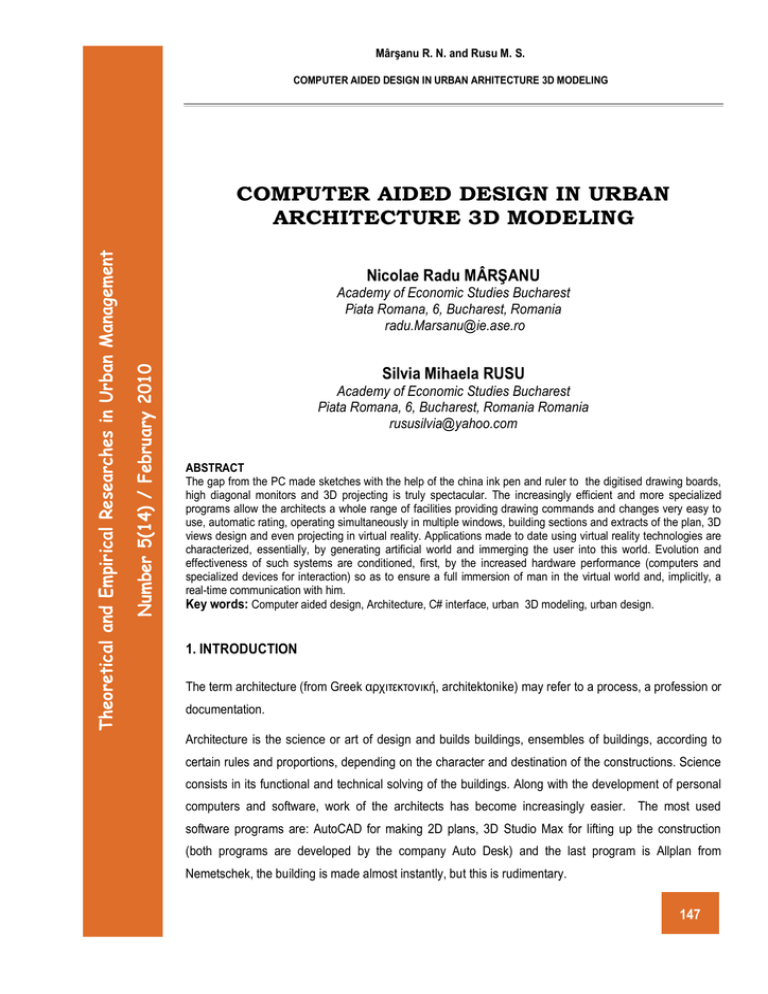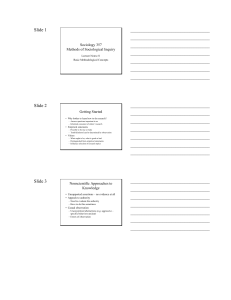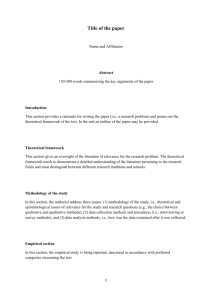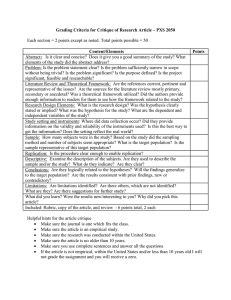computer aided design in urban architecture 3d modeling
advertisement

Mârşanu R. N. and Rusu M. S.
COMPUTER AIDED DESIGN IN URBAN ARHITECTURE 3D MODELING
Nicolae Radu MÂRŞANU
Academy of Economic Studies Bucharest
Piata Romana, 6, Bucharest, Romania
radu.Marsanu@ie.ase.ro
Number 5(14) / February 2010
Theoretical and Empirical Researches in Urban Management
COMPUTER AIDED DESIGN IN URBAN
ARCHITECTURE 3D MODELING
Silvia Mihaela RUSU
Academy of Economic Studies Bucharest
Piata Romana, 6, Bucharest, Romania Romania
rususilvia@yahoo.com
ABSTRACT
The gap from the PC made sketches with the help of the china ink pen and ruler to the digitised drawing boards,
high diagonal monitors and 3D projecting is truly spectacular. The increasingly efficient and more specialized
programs allow the architects a whole range of facilities providing drawing commands and changes very easy to
use, automatic rating, operating simultaneously in multiple windows, building sections and extracts of the plan, 3D
views design and even projecting in virtual reality. Applications made to date using virtual reality technologies are
characterized, essentially, by generating artificial world and immerging the user into this world. Evolution and
effectiveness of such systems are conditioned, first, by the increased hardware performance (computers and
specialized devices for interaction) so as to ensure a full immersion of man in the virtual world and, implicitly, a
real-time communication with him.
Key words: Computer aided design, Architecture, C# interface, urban 3D modeling, urban design.
1. INTRODUCTION
The term architecture (from Greek αρχιτεκτονική, architektonike) may refer to a process, a profession or
documentation.
Architecture is the science or art of design and builds buildings, ensembles of buildings, according to
certain rules and proportions, depending on the character and destination of the constructions. Science
consists in its functional and technical solving of the buildings. Along with the development of personal
computers and software, work of the architects has become increasingly easier. The most used
software programs are: AutoCAD for making 2D plans, 3D Studio Max for lifting up the construction
(both programs are developed by the company Auto Desk) and the last program is Allplan from
Nemetschek, the building is made almost instantly, but this is rudimentary.
147
Mârşanu R. N. and Rusu M. S.
COMPUTER AIDED DESIGN IN URBAN ARHITECTURE 3D MODELING
The architect is concerned not only by how the building will look like and how it will fit into the
environment, but also by the bearing the capacity of walls, the existence of efficient systems to ensure
heating, ventilation, supply electricity and water. Architectural plans are drawings which show precise
These primitives are text, circle, rectangle, line, cube (parallelepiped right), scope, content, cylinder and
NURBS curves, which are based on mathematical functions. Primitives can be changed, illuminated and
animated, and areas can be covered with colors or images called textures.
For modeling primitives, in order to obtain the desired shape, there are three options:
Modeling by polygons
Modeling by NURBS or B-spline
Tools used for modifying the Surface tool surface
Modeling the polygons is the most common for the design than any other modeling technique, because
it allows control over individual polygons allowing efficient optimization. Usually the modulator starts with
one of the predefined primitives of 3D Sudio Max software and using bevel and extrude (to lean and to
push) tools new details to the model will be added. A more advanced alternative for the polygons is
NURBS or B-spline modeling. It smoothes the surfaces by eliminating the straight margins of a polygon.
NURBS modeling is a precise mathematical representation of surfaces, as those used for the machine,
which can be exactly reproduced at any resolution, whenever is necessary. Surface tool is a tool used
for the creation of normal 3D Sudio Max spline, and then applying a modifier called surface. This
surface modifier makes a surface from three or four points in a network.
Microsoft Visual Studio is an integrated development environment (IDE) from Microsoft. It can be used
to develop applications of the console type or graphical interface using the Windows Forms software.
While several implementations of the notebook requirements exist, Visual C # is by far the most
commonly used. In most contexts, a reference to "C #" represents "Visual C #”. C # is a simple
language, with around 80 keywords and 12 predefined types of data. It enables structured,
modular, and object-oriented programming, according to the modern aspects of the
professional programming. The basic principles of programming on object are fundamental
elements of C# programming. Unlike C++, it contains a number of new types of data or
different data functions and in the spirit of achieving secure code sequences, some features
148
Number 5(14) / February 2010
3D Studio Max software uses primitive graphic objects to obtain three-dimensional complex ones.
Theoretical and Empirical Researches in Urban Management
the various aspects of construction plans used for the development or presentation of ideas.
Mârşanu R. N. and Rusu M. S.
COMPUTER AIDED DESIGN IN URBAN ARHITECTURE 3D MODELING
were added (interfaces and delegation), diversified (struct type), modified (string type) or even
eliminated (multiple inheritance and pointers to functions).
I chose C # language for the opportunity of creating with it an easy accessible user interface.
2.1. Design the urban house
In order to realize the project, the architect must take into account certain aspects that he will discuss
with the owner. A first aspect to be considered refers to the optimal positioning of the house on the
ground, following in this sense for the building to be oriented south or regarding the neighborhood in
Number 5(14) / February 2010
Theoretical and Empirical Researches in Urban Management
2. DESIGNING AND BUILDING THE URBAN HOUSE
order to determine the shape and volume of the house for a smooth integration into the architecture of
the area. In our application the design was made manually, without many details, in order to obtain an
overall picture of the scale and proportion to be followed according to the construction certificate. Then
using the 3D Studio Max software, the final plan of the house was made, which included the doors, the
windows and the roof (Figure 1). A more detailed plan will be made for the customers, where it will be
written what each space represents, where the doors, windows and dimensions are.
FIGURE 1 - HOUSE PLAN
2.2. Construction the urban house
In order to facilitate the construction of the house in 3D Studio Max software, a plan for every three
viewpoints of the program will be created (front, side and top). A picture of every plan will be attached,
representing the sketches of the house in the three dimensions. Thus the house can be constructed
according to the conditions of the architect.
149
Mârşanu R. N. and Rusu M. S.
COMPUTER AIDED DESIGN IN URBAN ARHITECTURE 3D MODELING
2.2.1. The walls
3D Studio Max software offers the rapid solution in lifting up the wall with the help of the Wall (Create AEC Objects - Wall). This function is best used for lifting up the internal walls or construction plans,
These are the three perspectives for lifting the house
FIGURE 2 - CREATING WALLS
A different method will be used because the plan by which the construction must be lifted has a rigid
form: a rectangle in the ‘TOP’ viewpoint is built (Figure 3). After its construction, it turns into an editable
polygon.
FIGURE 3 - SECOND MODE FOR CREATING WALLS
Then the function in which only the shapes of the form are chosen is selected and the rectangle is
modified so that by pressing the Shift key the tracing of the next wall left or right is allowed.
2.2.2. The floor
The floors will be built from the some plane (Create - Standard Primitives - Plane). Each plan
corresponds to a room, which are built in the Top viewpoint.
150
Number 5(14) / February 2010
.
Theoretical and Empirical Researches in Urban Management
where the walls form an easy to follow shape (Figure 2).
Mârşanu R. N. and Rusu M. S.
COMPUTER AIDED DESIGN IN URBAN ARHITECTURE 3D MODELING
2.2.3. The roof
The roof is the most difficult part in building a house. The steps in the process of making this
component are the following:
by using the loop function, then using extrude and a geometrical shape is obtained;
2. In order to create the tiles the next will be needed:
several segments must be added in order to shape the tiles. This is achieved by selecting the
three edges and connecting them (Figure 4).
Number 5(14) / February 2010
Theoretical and Empirical Researches in Urban Management
1. Start with a rectangle and then turn it into an editable polygon. All the polygons will be selected
with all new segments selected the Chamfer function is used to create the space between
them.
4. At this point we will have an approximately number of vertical lines. To complete the
construction of the tiles the Slice Plane instrument is used. The yellow square that will appear
will be moved bit by bit down, and each time this operation is made the Slice button is preset.
5. The last part is to use Chamfer for the just obtained horizontal lines.
FIGURE 4 - CREATING THE ROOF
2.2.4. The windows
3D Studio Max software has an easy to implement solution, with options for building all types of
windows. They can be found
as follows: Create - AEC - Pivoted Window (Figure 5).
Types of windows:
Fixed Lights represent those windows which have no possibility of opening. These are the
ones in 3DStudio Max: Create - AEC Objects - Fixed Window;
151
Mârşanu R. N. and Rusu M. S.
Light Open represents a window that can be opened having the grip system hanged or pivotal
by the framework and can be opened from the inside. Opening windows can be classified
according to how it opens. These can be horizontally or vertically sliders (Figure 6) .
FIGURE 6 - VERTICALLY WINDOWS SLIDERS
2.2.5. The doors
Today, buildings have heated spaces, so you do not have doors to keep heat in separate rooms. Like
windows, doors can be built using a function of the program. It is as follows: Created - AEC Objects Doors. After these are positioned one can set if the door is simple or with panels.
3. URBAN HOME FURNISHING
Furniture is the way you live your life every day. Here you should start with all the choices in your
house: a functional and welcoming kitchen, a comfortable sitting room which invites you to relax, a quiet
bedroom where you can charge your batteries at the end of each day.
3.1. First bedroom (Figure 7)
3.1.1. Bed
The front side of the bed was created from a rectangle, which will be shaped as desired, and finally
extruded. For the rear a clone of the just created front part will be created. The legs of the bed are four
152
Number 5(14) / February 2010
FIGURE 5 - PATH FOR WINDOWS
Theoretical and Empirical Researches in Urban Management
COMPUTER AIDED DESIGN IN URBAN ARHITECTURE 3D MODELING
Mârşanu R. N. and Rusu M. S.
COMPUTER AIDED DESIGN IN URBAN ARHITECTURE 3D MODELING
parallelepipeds. The link between the two sides is achieved by attaching two parallelepipeds (made in
Number 5(14) / February 2010
Theoretical and Empirical Researches in Urban Management
length), one side and the other of the body.
FIGURE 7 - FIRST BEDROOM
3.1.2. Nightstands
It all starts from a rectangle, which forms the side of the nightstand, which is shaped in the part after the
shape of the legs. The extrude and chamfer tools will be used. It will be cloned and the two parties are
merged into a cube, which represent the back of the nightstand. The shelves will also be cubes, which
are placed at different levels. In the first shelf a drawer will be put, having as a handle a very thin
cylinder.
3.1.3. Cushions
A cube is drown and in the left viewpoint the two median points from the extremes will be selected and
placed below, as to give the impression that the cushion has its ends down. The same operation is
performed in the Front viewpoint.
The last phase in the realization is the one in which the bumps of the surface are made. The Soft
Selection instrument will be used. The falloff value will be changed to obtain different results when the
points will move in different directions. Finally Mesh Smooth will be used.
3.2. Second bedroom (Figure 8)
This is done using primitive geometric shapes such as cube, rectangle, cylinder (for handles) and a
semicircle for the top. To achieve the desired forms extrude and chamfer tools will be used. They will be
used to round off the corners, to size irregular lateral parts (modeling by points is chosen from the
editable polygon; the superior points will be moved to the outside with move).
153
Mârşanu R. N. and Rusu M. S.
Seats are made from a cube, with feet made of cylinders and rounded two times. The feet of the chairs
will be cloned for the table. Two cubes will be applied: one for the drawer and one for the top part. The
support for the books is made of two lines in the form of V, then we use extrude to transform it into a 3D
form.
3.3. Bathroom (Figure 9)
FIGURE 9 - BATHROOM
3.3.1 Sink
The making of the sink and its taps was a complex process, as follows:
1. It is made from a cylinder of which the bottom is cleared. Using the Loop function, all the
polygons are selected to increase the distance from the center. The extrude function is used
for the depth of the sink, having a small and negative value. A new segment around the center
is created to form the support for the taps. This is done by selecting all the edges and using the
Connect function. Then, the created segment is moved to the outside of the cylinder. Six points
are moved from the back to the front side to obtain the support.
154
Number 5(14) / February 2010
FIGURE 8 - SECOND BEDROOM
Theoretical and Empirical Researches in Urban Management
COMPUTER AIDED DESIGN IN URBAN ARHITECTURE 3D MODELING
Mârşanu R. N. and Rusu M. S.
COMPUTER AIDED DESIGN IN URBAN ARHITECTURE 3D MODELING
2. The final depth of the sink is given by selecting the other polygons and using the extrude
function, this time using a much higher value. Then with the bevel we obtain the shape of the
sink (this function will be used two-three times, with small values).
Remove the center lines of the form with Backspace key.
The taps are made of two overlapped spheres, the above being smaller. The link between the two is
obtained using the Bridge function (one chooses the bottom of the first and the upper of the lowest). To
give the ornament that links the sink and the tap, the bottom of the entire shape is selected and with the
help of with extrude, bevel and Move functions we obtain what we want.
The battery is also a cylinder, but this time the Blend function is used to form the curve.
Number 5(14) / February 2010
Theoretical and Empirical Researches in Urban Management
The desired angle and the part where the curve is wanted are chosen. Mesh Smooth is certainly used
for these forms.
The same principles will be used for the sink and the closet from the kitchen. Of course they
will be changed according to furniture specifications.
3.3.2 Shower cabin
The cabin is made from a simple rectangle. It will rise three times in different proportions, in order to
achieve different components. The Chamfer function is used for corners because when we turn on the
Turbo Smooth function these will keep their perpendicularities. By Chamfer we also achieve the form of
the shower cabin. The functions used for the sink will also be used here for the depth.
3.3.3 Toilet vase
Start with a Vertex rectangle. The points are modeled using the Vertex mode in order to get the shape
of the vase. The same steps as above are respected for the depth of the vase. For the lid we use a
rectangle, which in the Top view mode modifies itself by the shape of the vessel. The interior parts are
deleted, and the top part is left as it is. Shell and Mesh Smooth will be used for flattening with two or
three iterations. The action by which it gets cleaned is turned on by a button placed in the wall.
3.4 Kitchen (Figure 10)
3.4.1 Refrigerator
This is a simple form to create. It is simply a rectangle that was divided both ways with the help of
Connect function. Then to give the feeling of doors, polygons have been selected from the segments
155
Mârşanu R. N. and Rusu M. S.
COMPUTER AIDED DESIGN IN URBAN ARHITECTURE 3D MODELING
and were extruded until almost the end of the shape. The handles are simple cylinders, the one for the
3.4.2 Cooker
All starting from a rectangle, we divide it by height in order to create the two spaces reserved for the
digital screen and glass from the oven. The buttons for the fire ignition were made from a semi-sphere
with the bade a little to the exterior.
The burners are made from circles, which were applied these functions: Shell and Mesh Smooth and
having checked the option to enable renderer and enable in viewport in order to give wide. In order to
make the glass of the oven one will choose Raytrace in the screen for choosing the material at the
option maps->reflection.
3.5 Living room (Figure 11)
FIGURE 11 - LIVING
ROOM
156
Number 5(14) / February 2010
FIGURE 10 - KITCHEN
Theoretical and Empirical Researches in Urban Management
cold box having enabled the Bend option, with a small value.
Mârşanu R. N. and Rusu M. S.
COMPUTER AIDED DESIGN IN URBAN ARHITECTURE 3D MODELING
3.5.1 Sofa and Armchairs
Both couch and armchair were made of a rectangle. The sections will rearrange for each one, in order
to lift up the handles. Then the Chamfer is used for each of the corners, because when we apply Turbo
Smooth or Mesh Smooth with three iterations, we don’t want these to be affected. The cushions are
3.5.2 TV
The support is built up from a rectangle, where the Slice Plane function is applied. With this we can
divide the rectangle so that the other sustaining part can lift up at 30 degrees angle. Then using the
common functions extrude and bevel we shall make the other parts of the TV.
Number 5(14) / February 2010
Theoretical and Empirical Researches in Urban Management
made of cubes, shaped in Top View by the form of each one. Legs are four simple cylinders.
3.5.3 Table and vases
The construction of the table starts with the sustaining supports. They will be built from a simple line
drawn obliquely that will take the shape of overlapping cones with the functions Lathe and Shell. The
parts that connect the legs and the two windows are made also from lines, but they will be drawn by a
specific shape. It is enough for the line to be drawn only for half of the form, because the functions
above can rebuild the other half.
The windows are also made from a line modulated shape, but the Extrude and Mesh Smooth functions
were applied for the shape to be uniform. The vase is built up by the same principles. Only the shape of
the outline and the type of used material are different. The window for materials opens and we choose
ARCHITECTURE instead of the Standard button. Then the desired material is applied in the Phisical
Qualities-Diffuse Map section. The same material is selected in the Special Effects–Bump section
(Figure 12).
FIGURE 12 - VASE
157
Mârşanu R. N. and Rusu M. S.
COMPUTER AIDED DESIGN IN URBAN ARHITECTURE 3D MODELING
4. PRESENTATION INTERFACE
The movie presentation is made in 3D Studio Max. This software has a multitude of extensions that can
save created animations. The most commonly used extensions are .bmp .png for images and .avi . mov
also be created in Adobe Flash or Adobe Director.
The Adobe Flash CS3 software uses the principle of key frame animation. Each graphical component is
attached to a different layer so that any changes made to the graphic objects may not affect other
components. Also, using Adobe Flash CS3 we can use Action Script. This is achieved by selecting and
placing the object code associated to the object in a special window. The process of rendering a photo
and the movies in 3D Studio Max will be firstly explained.
4.1 Photos
The pictures are the easier to obtain. Select the desired viewpoint, select the scene, and then by
pressing F9 a new window will appear. The graphical elements that will form the picture will be arranged
in this window. There are four ways to visualize the pictures, the four channels: red, blue, green and
black & white (Figure 13).
FIGURE 13 - RENDERING A IMAGE
4.2. Movies
The above function cannot be used for the movies. For this one must follow the way: Rendering–
Render. To create the desired animation, Active Segment time must be checked. Thus all, the active
158
Number 5(14) / February 2010
the user will be made in Visual Studio 2008 – C# after all four movies have rendered. This interface can
Theoretical and Empirical Researches in Urban Management
for movies. Each room will have a separate movie in order to obtain a very good quality. An interface of
Mârşanu R. N. and Rusu M. S.
COMPUTER AIDED DESIGN IN URBAN ARHITECTURE 3D MODELING
frames will get selected. Then we choose the quality of the movie from Output Size, with options for
Number 5(14) / February 2010
Theoretical and Empirical Researches in Urban Management
pictures, slide shows and videos.
FIGURE 14 - TIME CONFIGURATION WINDOW
Finally, push the Render button and the same window from the image rendering will appear.
Another method is as follows:
an outline of the route you want to view with a line is drawn and a camera is placed in Left
View. Focal distance is selected and the Show Cone option is checked;
the Time Configuration window is opened to set on how many frames the camera will follow
the route (Figure 14);
the Motion Tab window is opened to place the camera on the drawn route
select Position: Position XYZ and press the question mark. A new window will appear. The
Path Constraint button must be pressed in the window. Then select Add Path and then choose
the line drawn earlier. Also do not forget to check Follow and the Along Path option must have
value 0.
4.3 User interface
Of the three available programs, we have chosen to realize the interface in Visual Studio 2008 - C #.
Although it requires knowledge of programming, the application can be run on any platform because the
executable will be an .exe type and not an .swf type, like in Adobe Flash.
Pictures and animations made in 3D Studio Max were firstly chosen, to create the presentation of each
room. The interface will be composed of forms which include: Picture Box, WMP, buttons, Panels and
also contextual menus that allow print preview, page setup and print. We also put for each form, a icon
159
Mârşanu R. N. and Rusu M. S.
COMPUTER AIDED DESIGN IN URBAN ARHITECTURE 3D MODELING
representing a house in the upper left corner. An image that integrates all the rooms was chosen to
ease up the navigation in the whole house.
A panel was used for each room, the option for transparency was checked and the script above was
attached to it. In addition, when we choose to enter one of the rooms the previous form will close in
order not to create a suite of windows of form 2 (the one from which one chooses what room to view).
The script to close a form is: this.Close ();
Then the same steps will be followed for each of the rooms. Thus we have:
4.3.1 Integration of the video part(where it is necessary) in the form1
The script is:
private void IncarcaVideo()
{
string cale = @"C:\video\parinti.avi";
axWindowsMediaPlayer1.URL = cale;
axWindowsMediaPlayer1.settings.autoStart = true;
}
The function that loads the animation must be declared in the constructor of the form. The only
disadvantage of this component in C # is that: if the file is put on another computer or another partition
we must change the code a little and enter the new path. The two competing programs (Adobe Flash
and Director) integrate them automatically, without being necessary to copy them on that partition.
4.3.2 Integration the pictures in the form
This part of the application is the only one that does not require a script because it does not perform or
process any event. Right click and choose the option Choose Image to assign a picture to each Picture
Box. All the pictures are automatically stored in the Resources folder.
1
http://www.msdn.microsoft.com/enus/library/dd564585(VS.85).aspx
160
Number 5(14) / February 2010
private void button1_Click(object sender, EventArgs e)
{
Aplicatie frm2 = new Aplicatie();
frm2.Show();
}
Theoretical and Empirical Researches in Urban Management
The script that connects two forms is:
Mârşanu R. N. and Rusu M. S.
COMPUTER AIDED DESIGN IN URBAN ARHITECTURE 3D MODELING
4.3.3 Print Preview
The option Print Preview Document must be chosen from Tools in the first phase.
private void printPreviewToolStripMenuItem_Click(object sender, EventArgs e)
{
pageSetupDialog1.PageSettings = new System.Drawing.Printing.PageSettings();
if (pageSetupDialog1.ShowDialog() == DialogResult.OK)
printDocument1.DefaultPageSettings = pageSetupDialog1.PageSettings;
}
private void previewToolStripMenuItem_Click(object sender, EventArgs e)
{
printPreviewDialog1.ShowDialog();
}
Number 5(14) / February 2010
Theoretical and Empirical Researches in Urban Management
The script will be:
The first line allocates memory for the page settings type created object. The following condition is
whether the user closes the window by pressing the OK button, and then the settings for Object 1 will be
equaled with the ones from the setupdiag object.
For viewing each photo in a page, the script is:
private void printPreviewToolStripMenuItem_Click_2(object sender, EventArgs e)
{
this.printPreviewDialog1 = new PrintPreviewDialog();
this.printPreviewDialog1.Document = this.printDocument1;
this.printPreviewDialog1.Show();
}
This script first allocates memory for the picture that was selected for preview, then the property of the
document with the printer in set, although practically the application simulates the printing, by making it
only visual. The last instruction is to copy each picture in part because it was chosen the option of
printing a picture on a page.
4.3.4 Page Setup
We must drag the print Document instance from Tool Box, just like it was at print preview. The script will
be:
private void pageSetupToolStripMenuItem3_Click(object sender, EventArgs e)
{
pageSetupDialog1.PageSettings = new System.Drawing.Printing.PageSettings();
if (pageSetupDialog1.ShowDialog() == DialogResult.OK)
printDocument4.DefaultPageSettings = pageSetupDialog1.PageSettings;
}
4.3.5 Print
Here we also have to drag up the print tool from ToolBox and write the
161
Mârşanu R. N. and Rusu M. S.
COMPUTER AIDED DESIGN IN URBAN ARHITECTURE 3D MODELING
The last function from the actually played script draws the selected picture on the printing page.
Properties.Resources is the resource that will draw the picture with the name w. new
System.Drawing.Point (100, 100) is the place where the drawing will start. Upper left corner has the
coordinates: 0 and 0.
This script will have to be adapted for each picture in hand, with the name associated to the photo. The
final project will have this final form (Figure 15) :
FIGURE 15 - USER INTERFACE
For example inside of a room will look like this (Figure 16):
FIGURE 16 - INSIDE OF THE LIVING ROOM
162
Number 5(14) / February 2010
private void printToolStripMenuItem_Click(object sender, EventArgs e)
{
printDocument1.Print();
}
private void printDocument1_PrintPage(object sender, System.Drawing.Printing.PrintPageEventArgs e)
{
e.Graphics.DrawImage(Properties.Resources.w, new System.Drawing.Point(100, 100));
}
Theoretical and Empirical Researches in Urban Management
following code:
Mârşanu R. N. and Rusu M. S.
COMPUTER AIDED DESIGN IN URBAN ARHITECTURE 3D MODELING
6. CONCLUSIONS
Optimizing human-machine interface using virtual reality technology is certainly a topic of interest in
computer assisted design capability through this innovative tool to provide a contact between humans
In such an approach, the subject on which the designer works is a virtual prototype that is generated in
a particular initial state (situation) and can be reconstructed at any stage of the design process, without
a lot of effort. The main advantage is that, in general, everything is started from simple drawings and
can evolve to complex objects and ways of positioning them in the picture after some considerate in the
interior of a synthetic environment using 3D projecting techniques (traditional or modern).
Number 5(14) / February 2010
Theoretical and Empirical Researches in Urban Management
and the system of computer-aided design.
The prototype on which it operates in relation to ones own creativity and experience, the human
designer can be played in a natural context at any stage of development, so that fundamental defects,
adjustments, unwanted characteristics can be immediately identified and corrected, before the actual
achievement of the project.
Using this solution in architectural design, one can create an advanced environment, by simulating all
the "features" of a building, including lighting, heating and acoustics. One can also circulate through the
rooms, experience some features of the project (for example: colors, volumetric space, fixing the
position and intensity of the light, ventilation and devices of heating / cooling the room). We remind you
that, in the classic design, testing and verification of design solutions are achieved by carrying out
simulations to scale (or low physical models) of the designed object, and in a costly and in some cases
less relevant way. The computer-aided design in architecture based systems, based on virtual reality,
allow rapid generation of full scale virtual models, on which you can make direct experiments. An
additional advantage offered by this type of virtual simulation of the building (the final product of the
design process) arises from the fact that the eventual buyers (customers) can examine themselves the
project at an early stage, having the chance to see what they are buying and the chance to become
effective partners of the designing project through virtual reality. An approach that will present a real
interest in the coming years is the integration of a computer-aided design for architecture in a much
more complex system based on visual arts (virtual theater, teleconference, virtual museum).
The conclusion is that we can create a virtual world with the collaboration of the architects, visual artists,
teams of computer assisted designers, programmers and specialists in sound engineering can
contribute to the reconstruction of monuments and historical sites, thus conserving the authenticity of
such existent complexes.
163
Mârşanu R. N. and Rusu M. S.
COMPUTER AIDED DESIGN IN URBAN ARHITECTURE 3D MODELING
REFERENCES
Barry, R. (1999). The Construction of buildings (Vol. 1). Blackwell Science.
Barry, R. (1999). The Construction of buildings (Vol. 2). Blackwell Science.
Retrieved
from
Murdock, K. L. (2008). 3ds Max 8 (Vol. 1). Willey:Indiana.
164
http://www.msdn.microsoft.com/enus/library/
Number 5(14) / February 2010
Microsoft.
(2009).
MSDN.
dd564585(VS.85).aspx
Theoretical and Empirical Researches in Urban Management
Smeureanu, I., Dârdală, M. and Reveiu, A. (2004). Visual C#.NET. Bucureşti: Editura CISON.






